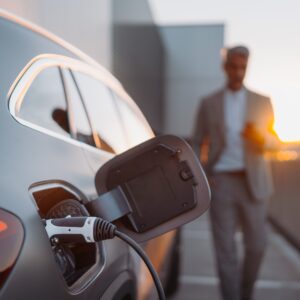
Insights
Making Your EV Game Plan: 6 Strategic Considerations To Think About First

With growing consumer enthusiasm for Electric Vehicles, funding pouring into new and better infrastructure, more manufacturers introducing new EV models, and regulations and incentives creating urgency, it’s no surprise that EV adoption is accelerating faster than experts previously predicted. But many convenience retailers have yet to start planning for the transition. While the industry continues to evolve, retailers can’t afford to wait much longer to figure out their approach.
Putting a strategic foundation into place now and aligning executives around key decisions will position retailers to take advantage of current EV trends, funding, and incentives and ensure they are ready to meet growing demand. Including these six areas in your early conversations will help shape an effective EV strategy that you can build out over time:
1) Investment Strategy. More and more EV charging stations are popping up next to traditional gas pumps at retailers around the country. Not long ago, Electric Vehicle Supply Equipment (EVSE) manufacturers and Charge Point Operators (CPOs) would pay for space at retailers’ locations to install the equipment. That’s flipping as data shows that charging stations are driving traffic and business inside stores.
Now, retailers need to consider making the investment in the equipment, and how you invest is likely the most critical strategic decision your business will make in the EV space. You have several options to consider.
- CPO-Owned: Following the traditional model, retailers can get paid by EVSE manufacturers and CPOs to install and run charging infrastructure on their sites. In this model, the CPO owns the equipment and takes care of the construction, installation, and any other infrastructure needs. There is less risk and capital investment for the retailer, but also less reward as the CPOs typically decide on the locations, set the pricing, and control the consumer data collected, which they can choose to share or not share with the retailers.
- Host-Owned: Retailers can also decide to own the charging infrastructure they install and host at their site. In this case, the retailer bears the cost of equipment, installation, and supporting infrastructure. The retailer controls all the decisions around price and location as well as the data, which can be leveraged to understand consumer buying preferences, optimize loyalty programs, and maximize revenue from consumers. While this model comes with higher risk, it also promises potentially higher rewards. It can be a smart strategic choice, especially for retailers that take advantage of National Electric Vehicle Infrastructure Formula Program (NEVI) funding and other incentives to help offset some of the investment costs.
- Hybrid: Some retailers are working with EVSE manufacturers and/or CPOs to customize arrangements where the retailer and the manufacturer share the costs, decision making, and access to the data. A hybrid model can offer a nice middle ground for retailers looking to balance risk versus reward.
2) Equipment Selection. The investment strategy is often tied to the type of equipment or charging infrastructure a retailer wants to offer. Different EVSE manufacturers will offer different options and rates. But retailers also need to consider consumer perceptions and preferences including demand for supercharging.
Tesla’s charging infrastructure is largely considered to be the best in the industry, further evidenced by the recent agreement to purchase Tesla charging equipment by BP Pulse. It has traditionally been accessible to Tesla drivers only, but this is starting to change. Other original equipment manufacturers (OEMs) are producing their own EV models and partnering with Tesla to gain access to their network. As a result Tesla is establishing a public network to ensure its own access to NEVI funding. In the meantime, other networks of charging infrastructure are more universally accessible, but need to be vetted carefully as there are varying degrees of quality and service.
You will need to think through the pros and cons of each option available alongside considerations such as what speed of charge you want to offer, the size of the network, and how the equipment and network you select affects pricing to arrive at the best equipment choices for your market and customers.
3) Competition. As with any strategic decision, retailers need to understand what their competitors are doing in the EV space. There is still a scarcity of charging infrastructure in many places around the country. But that’s changing rapidly, and consumers will soon have many more choices.
It’s important to remember that other fuel and convenience retailers are not your only competition in the EV space. Charging infrastructure will continue to be more widely available at other non-fuel retail locations and points of interest. Retailers need to think through how their options will compare in terms of equipment, location, and pricing. But in many cases, the consumer’s choice will be largely influenced by other amenities at the charging location. Consumers will be onsite for at least 15 to 30 minutes while charging their vehicles. So, amenities such as clean restrooms, food offerings, space to stretch the legs and walk the dog, business facilities, and wi-fi access can set one charging option apart from another.
4) Location. As convenience retailers build out their EV strategy and decide where to start first, they need to consider regional adoption trends. States like California have much higher EV adoption rates in large part due to the state’s legislative actions, but other states are quickly following suit and will introduce their own regulations sooner than later. At a local level, consumer travel patterns and behaviors must also be taken into account, along with EV adoption rates, to arrive at the best location plan for infrastructure investment and roll out.
The competitive landscape will obviously influence location selection. So will the investment model. Retailers that opt for a CPO-owned model may need to defer location decisions to the owners of the equipment.
5) Consumer Offering. A retailer’s offers are important to enticing consumers to choose their location over a competitor’s. More importantly, these offerings are key to maximizing revenue while customers are on site. This is where data comes into play and can be extremely valuable to understanding the consumer profile and what customers will be most interested in, or likely to purchase. It is crucial that the overall experience is consumer-centric rather than what has traditionally been vehicle-centric. This includes leveraging your real-estate more effectively to create multi-purpose destinations beyond what a typical convenience store would traditionally offer.
It is also critical to think through how EV charging offerings will tie into your existing customer loyalty programs, allowing you to understand utilization and the cross-shop of your EV drivers and use that to enable a quicker ROI on the investment.
6) Electricity Distribution. Electric utilities and energy companies have a stake in supporting EV adoption and many are offering rates and incentives that could benefit convenience retailers. Because electricity is regulated, tariffs, surcharges, and demand charges need to be researched and factored into pricing decisions. While adoption, and hence utilization, remains in the early stages, high demand charges could be a prohibitive factor in being able to put together a business case that supports the company’s investment goals. This is why adoption rates (now and in the future) are extremely important to understand.
In addition to the ongoing utility costs, interconnection costs such as a new transformer may be needed to bring additional power, but these also can create significant cost. The ability to host EV chargers and the costs of making the location ready will be extremely site specific; some locations require no upgrades while others may need major utility grid upgrades.
Start moving in the right direction.
Building a comprehensive EV strategy takes time and can be challenging given that there are still many unknowns and the industry and technology continue to evolve rapidly. But retailers that wait longer to get started risk getting left behind, especially as the pace of EV adoption keeps accelerating. Thinking through the key pillars of the strategy now can position your business to not only survive the transition to EVs, but to thrive on the other side. Stay tuned for more on this topic in our next post in this series.
Related Insights
Navigating the Future of Electric Vehicles Amidst Administrative Change
As we bid farewell to 2024 and welcome 2025, the future of the electric vehicle (EV) market in the US […]
The Changing Role of the CIO
It used to be that a retailer’s chief information officer would spend most of his or her time concerned with […]
Maximize Category Margins – Part 1: Overcoming Challenges Amid Rising Costs
The flood of escalating costs has been an ongoing challenge for retailers. Though balancing the protection of category margins while […]
Is Tesla the New Oil Major?
A Leader Amongst Followers When we hear the name Tesla, right or wrong, we immediately think about the brand that […]
Want to stay in touch? Subscribe to the Newsletter






